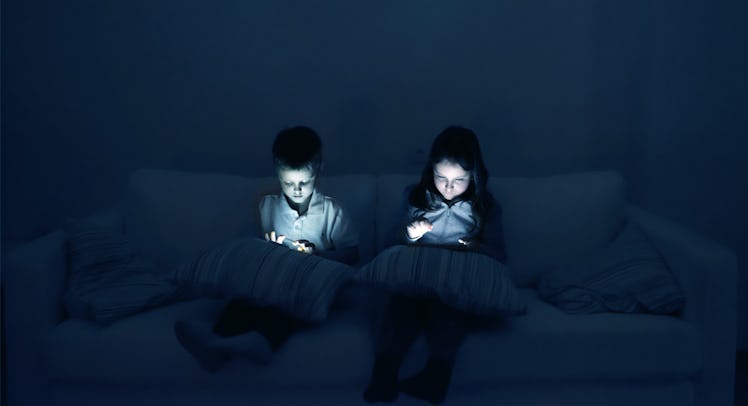The Truth About Blue Light, Sleep, And Your Kids
Blue light disrupts kids' sleep, and it's everywhere. Here's what parents can do.

Tablets, smartphones, and other mobile devices can be a huge help for parents, whether it’s keeping kids entertained on long car rides or distracting them while you knock out some work. Besides, with the explosion of kid gadgets, educational apps, and creativity-sparking software, screen time can do children a lot of good, too.
However, handy as they are, these devices have several downsides. They could lead a preschooler to scream for more screen time instead of playing make-believe, for instance, or hinder a middle-schooler’s ability to read other people’s emotions. And then there is the fact that they can severely mess with kids’ sleep.
Tablets, TVs, computers, and cellphones all emit blue light, which has been proven to disrupt sleep. Blue light interferes with the body’s natural sleep/wake cycle, called the circadian rhythm, by suppressing production of melatonin, the hormone that helps the body and brain wind down.
“We have receptors in our eyes, discovered about 10 years ago, that are directly affected by the blue spectrum,” says sleep psychologist Michael Breus, Ph.D., author of The Power of When and two other sleep books. “When this light goes through the pupil and hits the optic nerve, it sends a signal to the pineal gland to turn off the melatonin faucet in the brain.”
Although other wavelengths can also disrupt circadian rhythms, blue light is especially good at it. Harvard researchers discovered that 6.5 hours of blue light exposure stymies melatonin for twice as long as other spectra, delaying sleep a whole three hours.
During the daytime, squelching melatonin production is a good thing. It helps us stay alert, think clearly, and feel happy. For millennia, this job fell solely to the sun, which emits way more blue light than any manmade device. But unlike tablets and smartphones, the sun doesn’t follow children into their bedrooms at night. It sets, signaling to their bodies that bedtime is near. But when kids use blue light-emitting devices long into the evening, it keeps them wired when they should be yawning.
But the problem isn’t just nighttime use — it’s also the totality of blue light exposure. And since kids are increasingly using smartphones and tablets at daycare, school, and home (and in the case of teenagers, everywhere), the hours of screen time can pile up pretty quickly. It can easily outweigh the amount of blue light exposure you got watching DuckTales after school and typing the occasional book report on a clunky desktop.
On top of all the screen time, today’s children are also getting blue light from LED bulbs. While these are excellent energy savers, they emit more blue light than incandescent bulbs. With more homes and public places now decked out in LEDs, kids are exposed to blue light like never before.
So how does all this blue light exposure really impact a child’s health? First, it can take them longer to fall asleep, making it tough to get their recommended eight to 13 hours of shuteye each night. According to the National Sleep Foundation, kids between 6 and 17 years old who have at least one electronic device in their bedroom sleep one full hour less on school nights.
Sleep quality also takes a hit. A 2017 Israeli study found that people woke up nearly twice as many times during the night after being exposed to blue light versus red light. Plus, blue light kept their body temp from dropping like it’s supposed to during slumber, sabotaging sleep quality even more.
When kids either don’t get enough sleep or don’t sleep soundly, they suffer the same consequences as adults: brain fog, poor memory, and mood swings, to name a few. Additionally, sleep-deprived children are more likely to have behavioral problems such as aggressiveness or hyperactivity and struggle to succeed in school. Last year, a fascinating study of more than a thousand children tracked since birth revealed that those who hadn’t gotten sufficient sleep as toddlers and preschoolers had more issues with attention, emotional control, and problem-solving abilities at age 7. And, just like with adults, if sleep deprivation continues for a child, their risk of weight gain, diabetes, and other serious physical health issues goes up.
To minimize the negative impacts of blue light exposure, the American Academy of Pediatrics recommends limiting the amount of kids’ entertainment screen time to two hours a day. Also keep tablets and other media devices out of their bedrooms as much as possible. Set a digital curfew, too, when all blue light — emitting devices, including cellphones and TVs, are switched off. It’s best if that’s two hours before bedtime. A curfew is trickier to enforce with older kids who may need a computer or tablet for homework, so at least dim the brightness of their screen if possible — but absolutely hold your ground if they’re Snapchatting, texting, or watching TV.
This article was originally published on